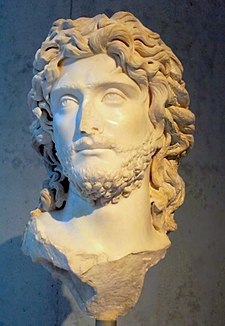| T. J. Sauromates II | |||||
|---|---|---|---|---|---|
 Marble bust of Sauromates II, Acropolis Museum Marble bust of Sauromates II, Acropolis Museum | |||||
| King of the Bosporus | |||||
| Reign | 172–210 | ||||
| Predecessor | T. J. Eupator | ||||
| Successor | T. J. Rhescuporis III | ||||
| Born | Bosporan Kingdom | ||||
| Died | 210 (?) Bosporan Kingdom | ||||
| Issue | T. J. Rhescuporis III | ||||
| |||||
| House | Tiberian-Julian dynasty | ||||
| Father | T. J. Rhoemetalces | ||||
| Religion | Greek Polytheism | ||||
Tiberius Julius Sauromates II Philocaesar Philoromaios Eusebes, also known as Sauromates II (Greek: Τιβέριος Ἰούλιος Σαυρομάτης Β΄ Φιλοκαῖσαρ Φιλορωμαῖος Eὐσεβής, Philocaesar Philoromaios Eusebes, the epithets meaning "friend of Caesar, friend of Rome, pious one") was a Roman client king of the Bosporan Kingdom. His coins are known from the period 172–210, probably accounting for his entire reign.
Lineage
Tiberius Julius Sauromates II is known from inscriptions to have been the son of the Bosporan king Rhoemetalces. Sauromates II's predecessor Eupator might have been his uncle.
Although his surname "Sauromates" indicates alleged Sarmatian ancestry by marriages to Sarmatian princesses, this does not necessarily mean those who bore the title were actual Sarmatians. His Bosporan royal dynasty had been established in the 1st century AD by Tiberius Julius Aspurgus and his son Mithridates (i.e. the son and grandson, respectively, of Bosporan ruler Asander and his queen Dynamis). Aspurgus and Mithridates were not only related to the ruling house of Thrace, but were also descendants of both Mithridates VI Eupator of Pontus (both a Persian and Seleucid-Greek by lineage) and the Roman triumvir Mark Antony through Antonia Tryphaena, Queen of Thrace and her mother Pythodorida of Pontus.
Life
Eupator died at some point between 170 and 172 and Sauromates II succeeded him as Bosporan King, reigning from that date until his death in 210/211. He expressed his royal title in Greek on his coinage: ΒΑΣΙΛΕΩΣ ΣΑΥΡΟΜΑΤΟΥ or of King Sauromates. He was a contemporary of the Roman Emperors Marcus Aurelius, Commodus, Pertinax, Didius Julianus, Septimius Severus and Caracalla.

Little is known of the life and reign of Sauromates II. According to surviving coinage, he appeared to be a religious person who was involved in the worship of the Goddess Aphrodite and her cult. In 193, Sauromates II finished a military campaign against the Scythians and Sirachi tribes, and successfully defeated them. These victories are known from an inscription found in Tanais, dedicating and celebrating the King's military victories. This military campaign perhaps began in 186, when it spurred a financial crisis within the Bosporan Kingdom. In order to improve the flagging economy of his kingdom, Sauromates II initiated a series of monetary reforms in 186 that, over the course of a decade, gradually reduced the weight of his bronze coinage while increasing the circulation of the golden stater. In the last decade of the 2nd century AD, the coins of Sauromates II also commonly featured the portrait of Septimius Severus; it is not known whether or not this was a command given by the Roman emperor to his client or if the Bosporan king did this on his own volition.
The name of Sauromates' wife is not preserved. They had at least one son, Rhescuporis III, who succeeded Sauromates II in 210/211.
See also
References
Citations
- Ivantchik (2014), pp. 168–170.
- ^ Mitchiner, Michael (1978). The Ancient & Classical World, 600 B.C.-A.D. 650. Hawkins Publications. p. 69. ISBN 978-0-904173-16-1.
- ^ Settipani, Christian (2006). Continuité des élites à Byzance durant les siècles obscurs: les princes caucasiens et l'Empire du VI:e au IX:e siècle (in French). Paris: De Boccard. p. 408. ISBN 978-2-7018-0226-8.
- Mommsen (2005), p. 314 footnote 1.
- Sullivan (1990), p. 324-325.
- ^ Mommsen (2005), pp. 312–314, 314 footnote 1.
- Engels (2017), p. 75.
- Sullivan (1990), pp. 323–325.
- Mayor (2011), pp. xviii, 417 footnote 54.
- Huzar (1978), pp. 230–231.
- Myzgin & Beidin (2012), p. 75.
- ^ Zograph (1938), p. 108.
- Zograph (1938), pp. 106–111.
- Zograph (1938), p. 108, 110-111.
Sources
- Myzgin, Kirill; Beidin, Georgiy (2012), "Finds of Bosporan Coins in the Territory of the East-European Barbaricum", in Anna Kowalczyk; et al. (eds.), Notae Numismaticae, vol. VII, Kraków: Muzeum Narodowe w Krakowie i Autorzy, pp. 57–76, ISSN 1426-5435.
- Engels (2017), "The Seleucid and Achaemenid Court: Continuity or Change?", in Andrew Erskine; Lloyd Llewellyn-Jones; Shane Wallace (eds.), The Hellenistic Court: Monarchic Power and Elite Society from Alexander to Cleopatra, Ceredigion: The Classical Press of Wales, pp. 69–100, ISBN 978-1-910589-62-5.
- Huzar, Eleanor Goltz (1978), Mark Antony: a Biography, Minneapolis: University of Minnesota Press, ISBN 0-8166-0863-6.
- Ivantchik, Askold (2014), "Roman Troops in the Bosporus. Old Problem in the Light of a New Inscription Found in Tanais", Ancient Civilizations from Scythia to Siberia, 20, Brill: 165–194.
- Mayor, Adrienne (2011), Poison King: The Life and Legend of Mithradates, Rome's Deadliest Enemy, Princeton: Princeton University Press, ISBN 978-0691-15026-0.
- Mommsen, Theodore (2005) , William P. Dickson (ed.), The provinces of the Roman empire from Caesar to Diocletian, translated by William P. Dickson, Ann Arbor, Michigan: University of Michigan Library.
- Sullivan, Richard, D. (1990), Near Eastern Royalty and Rome, 100-30 BC, Toronto: University of Toronto Press, ISBN 0-8020-2682-6.
{{citation}}: CS1 maint: multiple names: authors list (link) - Zograph, A. N. (1938), "Sauromates II's Reform of the Currency", The Numismatic Chronicle and Journal of the Royal Numismatic Society, 18: 99–116, JSTOR 42664185.
Further reading
- Rome, the Greek world, and the East, by Fergus Millar, Hannah M. Cotton and Guy M. Rogers, Vol 2: Government, Society & Culture in the Roman Empire
External links
| Preceded byEupator | King of the Bosporus 172–210 |
Succeeded byRhescuporis III |